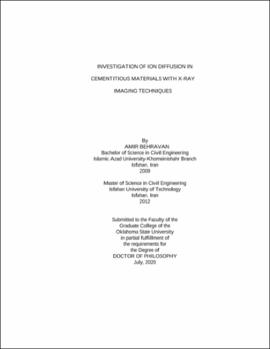| dc.contributor.advisor | Ley, Matthew Tyler | |
| dc.contributor.author | Behravan, Amir | |
| dc.date.accessioned | 2023-04-20T18:24:48Z | |
| dc.date.available | 2023-04-20T18:24:48Z | |
| dc.date.issued | 2020-07 | |
| dc.identifier.uri | https://hdl.handle.net/11244/337444 | |
| dc.description.abstract | Concrete is susceptible to the migration of highly deleterious ions. The external penetration of ions into cementitious materials is the primary factor influencing the longterm durability of concrete structures. There are several test methods to study ion transport in cement-based materials. Most of the applied test methods are time-consuming, destructive, labor-intensive, and sensitive to factors like temperature or chemistry of the system. Furthermore, most of the established test methods cannot represent the exact multi-mechanistic transport of fluids into the concrete. Also, in most of the current test methods, chemical reactions between the diffused ions and binders are not considered. It has been shown that the application of micro X-ray fluorescence (µXRF) and Transmission X-ray microscopy (TXM) helps to get a more fundamental observation of ion transport in acementitious system. The present study uses the direct and non-destructive TXM technique to observe ion penetration into alternative cementitious materials (ACMs) paste sample scured for different durations. It is important because the performance of ACMs must be well understood before their widespread use. This work applies µXRF to compare the performance of ACMs in both laboratory and field applications. This is important because the long-term performance of ACMs is not well understood. This study aims to develop asystematic approach to use a medical x-ray source to check the ion penetration into a cementitious system called checking ion penetration (CHIP), which is a rapid non-destructive x-ray technique able to provide useful fundamental observations of ion movement in cement-based materials. This work shows the CHIP is a reliable technique to measure the mass transport properties of a system and can measure the impact of curing time on the ion diffusivity of blended cement pastes partially replaced with seven types offly ash. The results from this study help to expand our understanding of ion transport incement-based materials and to greatly improve the current models of mass transport and service life predictions of the concrete. This can help a large amount of money to be saved in repair, maintenance, and management of concrete structures. | |
| dc.format | application/pdf | |
| dc.language | en_US | |
| dc.rights | Copyright is held by the author who has granted the Oklahoma State University Library the non-exclusive right to share this material in its institutional repository. Contact Digital Library Services at lib-dls@okstate.edu or 405-744-9161 for the permission policy on the use, reproduction or distribution of this material. | |
| dc.title | Investigation of ion diffusion in cementitious materials with x-ray imaging techniques | |
| dc.contributor.committeeMember | Delatte, Norb | |
| dc.contributor.committeeMember | Hartell, Julie Ann | |
| dc.contributor.committeeMember | Sarin, Pankaj | |
| osu.filename | Behravan_okstate_0664D_16863.pdf | |
| osu.accesstype | Open Access | |
| dc.type.genre | Dissertation | |
| dc.type.material | Text | |
| dc.subject.keywords | CHIP technique | |
| dc.subject.keywords | chloride penetration | |
| dc.subject.keywords | concrete durability | |
| dc.subject.keywords | corrosion | |
| dc.subject.keywords | ion diffusion | |
| dc.subject.keywords | x-ray imaging | |
| thesis.degree.discipline | Civil Engineering | |
| thesis.degree.grantor | Oklahoma State University | |
